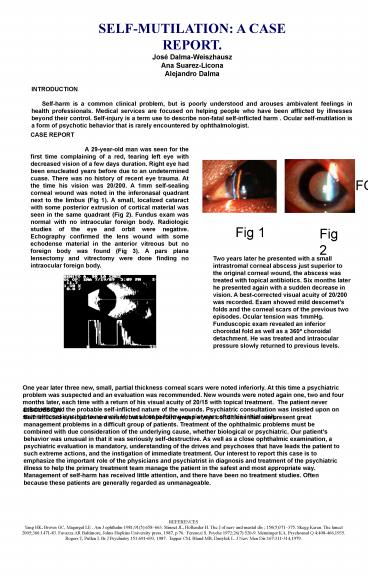REFERENCES - PowerPoint PPT Presentation
1 / 1
Title:
REFERENCES
Description:
Ocular self-mutilation is a form of psychotic behavior that is rarely ... SELF-MUTILATION: A CASE REPORT. Jos Dalma-Weiszhausz. Ana Suarez-Licona. Alejandro Dalma ... – PowerPoint PPT presentation
Number of Views:24
Avg rating:3.0/5.0
Title: REFERENCES
1
SELF-MUTILATION A CASE REPORT. José
Dalma-Weiszhausz Ana Suarez-Licona Alejandro
Dalma
INTRODUCTION Self-harm is a common clinical
problem, but is poorly understood and arouses
ambivalent feelings in health professionals.
Medical services are focused on helping people
who have been afflicted by illnesses beyond their
control. Self-injury is a term use to describe
non-fatal self-inflicted harm . Ocular
self-mutilation is a form of psychotic behavior
that is rarely encountered by ophthalmologist.
CASE REPORT A 29-year-old man was seen for the
first time complaining of a red, tearing left eye
with decreased vision of a few days duration.
Right eye had been enucleated years before due to
an undetermined cuase. There was no history of
recent eye trauma. At the time his vision was
20/200. A 1mm self-sealing corneal wound was
noted in the inferonasal quadrant next to the
limbus (Fig 1). A small, localized cataract with
some posterior extrusion of cortical material was
seen in the same quadrant (Fig 2). Fundus exam
was normal with no intraocular foreign body.
Radiologic studies of the eye and orbit were
negative. Echography confirmed the lens wound
with some echodense material in the anterior
vitreous but no foreign body was found (Fig 3). A
pars plana lensectomy and vitrectomy were done
finding no intraocular foreign body.
Fotos FO
Fig 1
Fig 2
Two years later he presented with a small
intrastromal corneal abscess just superior to the
original corneal wound, the abscess was treated
with topical antibiotics. Six months later he
presented again with a sudden decrease in vision.
A best-corrected visual acuity of 20/200 was
recorded. Exam showed mild descemets folds and
the corneal scars of the previous two episodes.
Ocular tension was 1mmHg. Funduscopic exam
revealed an inferior choroidal fold as well as a
360º choroidal detachment. He was treated and
intraocular pressure slowly returned to previous
levels.
One year later three new, small, partial
thickness corneal scars were noted inferiorly. At
this time a psychiatric problem was suspected and
an evaluation was recommended. New wounds were
noted again one, two and four months later, each
time with a return of his visual acuity of 20/15
with topical treatment. The patient never
acknowledged the probable self-inflicted nature
of the wounds. Psychiatric consultation was
insisted upon on several occasions but to no
avail. He was lost to follow-up six years after
his initial visit.
Fig 3
DISCUSSION Self inflicted eye injuries are a
rare, but an important group of eye conditions
that can present great management problems in a
difficult group of patients. Treatment of the
ophthalmic problems must be combined with due
consideration of the underlying cause, whether
biological or psychiatric. Our patients behavior
was unusual in that it was seriously
self-destructive. As well as a close ophthalmic
examination, a psychiatric evaluation is
mandatory, understanding of the drives and
psychoses that have leads the patient to such
extreme actions, and the instigation of immediate
treatment. Our interest to report this case is to
emphasize the important role of the physicians
and psychiatrist in diagnosis and treatment of
the psychiatric illness to help the primary
treatment team manage the patient in the safest
and most appropriate way. Management of self-harm
has received little attention, and there have
been no treatment studies. Often because these
patients are generally regarded as unmanageable.
REFERENCES Yang HK, Brown GC, Magargal LE .
Am J ophthalm 198191(5)658663. Stinnet JL,
Hollender H. The J of nerv and mental dis
150(5)371375. Skegg Keren. The lancet
20053661471-83. Favazza AR Baltimore, Johns
Hopkins University press, 1987, p 76. Ferenczi
S. Psyche 197226(7)520-9. Menninger KA.
Psychoanal Q 4408-466,1935. Rogers T, Pullen I.
Br J Psychiatry 151691-693, 1987. Tapper CM,
Bland MB, Danyluk L. J Nerv Men Dis
167311-314,1979.































